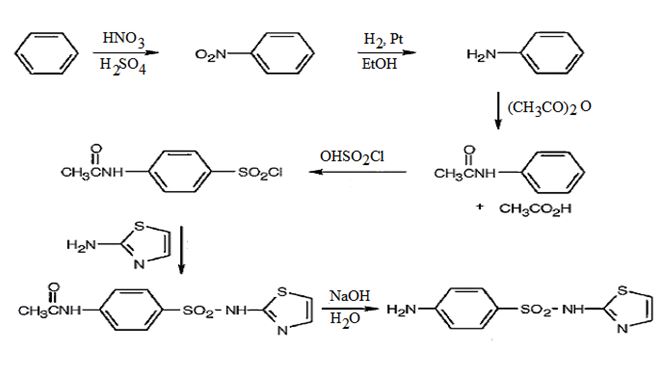
Interpretation:
Using benzene and any other necessary
Concept introduction:
The steps involved in the synthesis of sulfathiazole from benzene are i) Nitration of benzene ii) Reduction of nitrobenzene iii) Acetylation of the amino group iv) Chlorosulfonation of the anilide v) Treatment with 2-aminothiazole vi) Hydrolysis of the anilide to an amine.
To Show:
How to synthesize sulfathiazole starting from benzene and using any other necessary amines.
Answer:
The synthesis of sulfathiazole starting from benzene and using any other necessary amines is given below.

Explanation:
Nitration of benzene with Conc. HNO3 and Conc. H2SO4 yields nitrobenzene which on reduction with H2/Pt in ethanol gives aniline. Acetylation of aniline with acetic anhydride produces acetanilide. Chlorosulfonation of acetanilide leads to the formation of a p-chlorosulfonate as anilide group is orthp and para directing. Treatment of chlorosulfonate with 2-aminothiazole yields N-acetylsulfothiazole. Hydrolysis of N-acetylsulfothiazole yields sulfathiazole.
Conclusion:
The synthesis of sulfathiazole starting from benzene and using 2-aminothiazole is given below.

Trending nowThis is a popular solution!

Chapter 24 Solutions
Study Guide with Student Solutions Manual for McMurry's Organic Chemistry, 9th
- if the answer is no reaction than state that and please hand draw!arrow_forward"I have written solutions in text form, but I need experts to rewrite them in handwriting from A to Z, exactly as I have written, without any changes."arrow_forwardDon't used hand raiting and don't used Ai solutionarrow_forward
- Please correct answer and don't used hand raitingarrow_forwardreciprocal lattices rotates along with the real space lattices of the crystal. true or false?arrow_forwardDeducing the reactants of a Diels-Alder reaction vn the molecule on the right-hand side of this organic reaction be made in good yield from no more than two reactants, in one step, by moderately heating the reactants? ? Δ O If your answer is yes, then draw the reactant or reactants in the drawing area below. You can draw the reactants in any arrangement you like. • If your answer is no, check the box under the drawing area instead. Click and drag to start drawing a structure. Product can't be made in one step. Explanation Checkarrow_forward
- Predict the major products of the following organic reaction: Δ ? Some important notes: • Draw the major product, or products, of the reaction in the drawing area below. • If there aren't any products, because no reaction will take place, check the box below the drawing area instead. • Be sure to use wedge and dash bonds when necessary, for example to distinguish between major products that are enantiomers. Explanation Check Click and drag to start drawing a structure. Larrow_forward> Can the molecule on the right-hand side of this organic reaction be made in good yield from no more than two reactants, in one step, by moderately heating the reactants? ? Δ • If your answer is yes, then draw the reactant or reactants in the drawing area below. You can draw the reactants in any arrangement you like. If your answer is no, check the box under the drawing area instead. Explanation Check Click and drag to start drawing a structure. Х © 2025 McGraw Hill LLC. All Rights Reserved. Terms of Use | Privacy Center | Accesarrow_forwardPredict the major products of the following organic reaction: O O + A ? Some important notes: • Draw the major product, or products, of the reaction in the drawing area below. • If there aren't any products, because no reaction will take place, check the box below the drawing area instead. • Be sure to use wedge and dash bonds when necessary, for example to distinguish between major products that are enantiomers. Explanation Check Click and drag to start drawing a structure. eserved. Terms of Use | Privacy Center >arrow_forward
 Organic ChemistryChemistryISBN:9781305580350Author:William H. Brown, Brent L. Iverson, Eric Anslyn, Christopher S. FootePublisher:Cengage Learning
Organic ChemistryChemistryISBN:9781305580350Author:William H. Brown, Brent L. Iverson, Eric Anslyn, Christopher S. FootePublisher:Cengage Learning
 Introduction to General, Organic and BiochemistryChemistryISBN:9781285869759Author:Frederick A. Bettelheim, William H. Brown, Mary K. Campbell, Shawn O. Farrell, Omar TorresPublisher:Cengage Learning
Introduction to General, Organic and BiochemistryChemistryISBN:9781285869759Author:Frederick A. Bettelheim, William H. Brown, Mary K. Campbell, Shawn O. Farrell, Omar TorresPublisher:Cengage Learning


